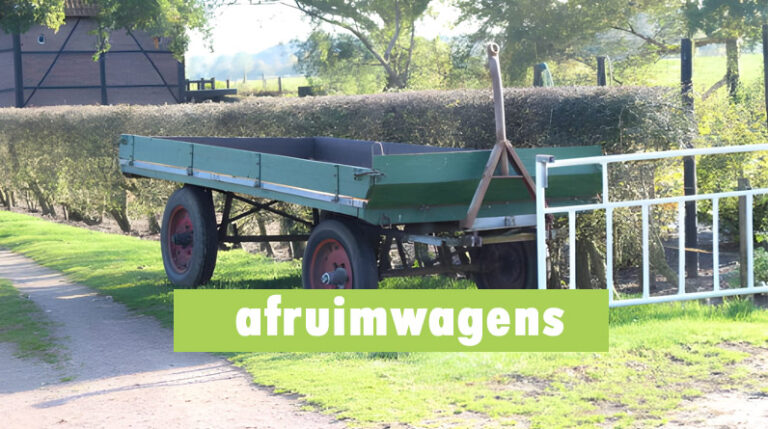In today’s efficiency-driven economy, the term “afruimwagens” represents two powerful solutions addressing distinct operational challenges across multiple industries. While the name might be unfamiliar to many, these specialized tools have become indispensable in restaurants, hotels, farms, and industrial operations worldwide. Understanding the dual nature of afruimwagens—as both hospitality clearing carts and agricultural transport vehicles—reveals fascinating insights into how similar engineering principles solve vastly different problems.
This comprehensive guide explores both applications of afruimwagens, helping business owners, hospitality managers, and agricultural professionals make informed decisions about implementing these efficiency-boosting tools in their operations.
Understanding Afruimwagens: A Term with Two Distinct Meanings
The term “afruimwagens” originates from Dutch, where “afruimen” means “to clear” and “wagens” translates to “wagons” or “vehicles.” This etymology perfectly captures the essence of these tools—they’re designed to clear, transport, and facilitate movement efficiently. However, industry context determines whether we’re discussing a three-tiered stainless steel cart in a restaurant kitchen or a robust agricultural vehicle navigating farm fields.
The Hospitality Definition
In hospitality settings, afruimwagens are multi-tiered clearing trolleys designed for transporting dishes, glassware, cutlery, and serving equipment from dining areas to washing stations. These mobile workstations feature smooth-rolling wheels, ergonomic handles, and organized shelving systems that enable rapid table turnover while maintaining impeccable hygiene standards.
The Agricultural Definition
In agricultural contexts, afruimwagens refer to specialized utility vehicles built for rugged terrain and heavy-duty farm work. These machines transport crops, spread organic materials, carry equipment, and perform various tasks that modern farming demands. They represent the mechanization of traditional farming practices, combining power with versatility.
Afruimwagens in Hospitality: Engineering Efficiency into Service
The hospitality industry operates on razor-thin margins where every minute counts. Afruimwagens have evolved from simple utility carts into sophisticated equipment that directly impacts profitability through improved operational flow.
Core Components of Hospitality Afruimwagens
- Multi-Tier Shelving System: Typically featuring 2-3 levels for categorizing items by type, weight, or cleanliness status
- Premium Wheel Systems: Rubber-coated, noise-dampening wheels with directional locks and brake mechanisms
- Hygienic Materials: Stainless steel (RVS) or food-grade polypropylene that resists corrosion and facilitates sanitization
- Ergonomic Design Features: Handle heights calibrated to reduce back strain and pushing fatigue
- Customizable Accessories: Waste bin attachments, cutlery dividers, glass racks, and tray rails
Measurable Impact on Hospitality Operations
Research into restaurant efficiency shows that implementing proper clearing systems can reduce table-clearing time by 40-60%. Consider these operational improvements:
| Metric | Without Afruimwagens | With Afruimwagens | Improvement |
|---|---|---|---|
| Table Clearing Time | 4-6 minutes | 2-3 minutes | 50% reduction |
| Staff Trips to Kitchen | 3-5 per table | 1-2 per table | 60% reduction |
| Dish Breakage Rate | 3-5% | 1-2% | 60% reduction |
| Staff Fatigue Score | 7.5/10 | 4.2/10 | 44% improvement |
Real-World Hospitality Applications
Fine Dining Restaurants: Stainless steel models with silent wheels maintain ambiance while enabling discrete clearing during multi-course meals.
Hospital Cafeterias: Heavy-duty models with antimicrobial coatings handle high-volume clearing while meeting strict hygiene protocols.
Event Catering: Lightweight, collapsible versions facilitate rapid setup and breakdown at temporary venues.
Educational Institutions: Durable plastic models withstand student handling while keeping costs manageable for large-scale deployments.
Afruimwagens in Agriculture: Mechanizing Farm Efficiency
Agricultural afruimwagens represent the evolution of traditional farm wagons into modern utility vehicles that address contemporary farming challenges. These machines bridge the gap between small-scale manual operations and large industrial equipment.
Key Features of Agricultural Afruimwagens
- Robust Powertrain: Diesel or electric engines providing 15-50 horsepower depending on application
- Terrain Adaptability: All-terrain tires, reinforced suspension, and ground clearance for navigating uneven fields
- Attachment Systems: Universal mounting points for plows, spreaders, seeders, and harvesting tools
- Load Capacity: Payload ratings from 500kg for compact models to 3,000kg for heavy-duty variants
- Weather Resistance: Corrosion-proof materials and sealed components for year-round operation
Types of Agricultural Afruimwagens
1. Standard Transport Models: Flatbed designs for moving harvested crops, equipment, and supplies across farm properties.
2. Tipper Variants: Hydraulic lift mechanisms enable quick unloading of bulk materials like grain, compost, or feed.
3. Specialty Agricultural Wagons: Purpose-built for specific crops such as grape harvesting, potato digging, or hay transportation.
4. Electric Afruimwagens: Battery-powered models gaining popularity for greenhouse operations and organic farms prioritizing sustainability.
Agricultural Impact and Case Studies
A 2024 study of small to mid-size farms implementing afruimwagens documented significant operational improvements. Farmers reported:
- 30-40% reduction in harvest-to-storage time
- 25% decrease in crop damage during transport
- 20% improvement in labor productivity
- 15% reduction in fuel costs compared to larger tractor operations
Case Example: A citrus farm in Limpopo, South Africa, integrated compact afruimwagens with specialized fruit bins. The result was a 35% increase in daily harvest capacity while reducing worker strain from manual carrying. The investment paid for itself within 18 months through improved efficiency and reduced crop bruising.
Comparing Both Applications: Shared Principles, Different Contexts

Despite serving completely different industries, both types of afruimwagens share fundamental design principles that reveal universal truths about efficient operations:
| Design Principle | Hospitality Application | Agricultural Application |
|---|---|---|
| Load Distribution | Multiple tiers prevent overloading single shelves | Low center of gravity prevents tipping on slopes |
| Ergonomic Design | Reduces server back strain and fatigue | Minimizes operator discomfort during long shifts |
| Durability | Stainless steel withstands daily cleaning chemicals | Reinforced frames endure harsh outdoor conditions |
| Maneuverability | Tight turning radius navigates crowded dining rooms | Compact dimensions fit through orchard rows and gates |
| Maintenance | Easy-clean surfaces prevent bacterial growth | Accessible components simplify field repairs |
Selecting the Right Afruimwagen for Your Needs
For Hospitality Managers
Assess Your Volume: High-volume establishments need multiple carts with 150-200kg capacity, while smaller venues can utilize compact models.
Material Selection: Stainless steel offers maximum durability for professional kitchens, while quality plastic suffices for cafeterias and casual dining.
Noise Considerations: Fine dining and healthcare settings require premium rubber wheels that operate silently, even when fully loaded.
Hygiene Requirements: Food service operations should prioritize seamless designs without crevices where bacteria can accumulate.
For Agricultural Operations
Terrain Analysis: Hilly farms need powerful engines and reliable braking systems, while flat operations can utilize lighter models.
Load Requirements: Calculate your typical payload and choose models with 20-30% additional capacity for flexibility.
Attachment Compatibility: Ensure the universal mounting system accommodates your existing implements and future tool purchases.
Fuel Considerations: While diesel models offer maximum power, electric variants reduce operating costs by 40-60% in appropriate applications.
Best Practices for Maximum Longevity
Hospitality Cart Maintenance
- Daily Cleaning Protocol: Wash with food-safe detergent, rinse thoroughly, and air dry completely
- Weekly Deep Clean: Disassemble removable components and sanitize all surfaces
- Monthly Inspections: Check wheel bearings, tighten fasteners, and lubricate moving parts
- Quarterly Professional Service: Have wheels professionally serviced and frames inspected for stress fractures
Agricultural Vehicle Maintenance
- Pre-Operation Checks: Inspect tires, fluid levels, and safety systems before each use
- Post-Operation Cleaning: Remove mud and debris to prevent corrosion and component wear
- Seasonal Overhaul: Complete fluid changes, belt replacements, and comprehensive system testing
- Proper Storage: Shelter vehicles from weather when not in use to extend component lifespan
Future Trends in Afruimwagen Technology
Both hospitality and agricultural sectors are witnessing technological integration that’s transforming traditional afruimwagens:
Smart Hospitality Carts: RFID tracking systems monitor cart location and usage patterns, optimizing fleet deployment during peak hours. Some restaurants now employ carts with integrated scales that automatically calculate clearing efficiency metrics.
Autonomous Agricultural Vehicles: GPS-guided afruimwagens are being developed for orchards and vineyards, capable of following predetermined routes for harvest collection without operator intervention.
Sustainability Focus: Both industries are transitioning toward recyclable materials, electric power systems, and modular designs that extend product lifecycles through component replacement rather than complete unit disposal.
IoT Integration: Connected sensors monitor maintenance needs, alert operators to potential failures before breakdowns occur, and provide usage analytics for operational optimization.
Conclusion: Investing in Operational Excellence
Whether you’re managing a bustling restaurant or operating a productive farm, afruimwagens represent more than simple transport solutions—they’re strategic investments in operational efficiency, worker safety, and long-term profitability. The most successful implementations share common characteristics: careful needs assessment, quality equipment selection, comprehensive staff training, and proactive maintenance programs.
As industries continue evolving toward greater efficiency and sustainability, afruimwagens will undoubtedly adapt through technological innovation while maintaining their core purpose: facilitating movement, reducing labor strain, and optimizing workflows. Understanding both applications of this versatile term provides valuable insights into universal operational principles that transcend industry boundaries.
By implementing appropriate afruimwagen solutions tailored to your specific operational context, you’re not just purchasing equipment—you’re investing in a proven methodology for enhancing productivity, protecting your workforce, and positioning your operation for sustained success in increasingly competitive markets.


